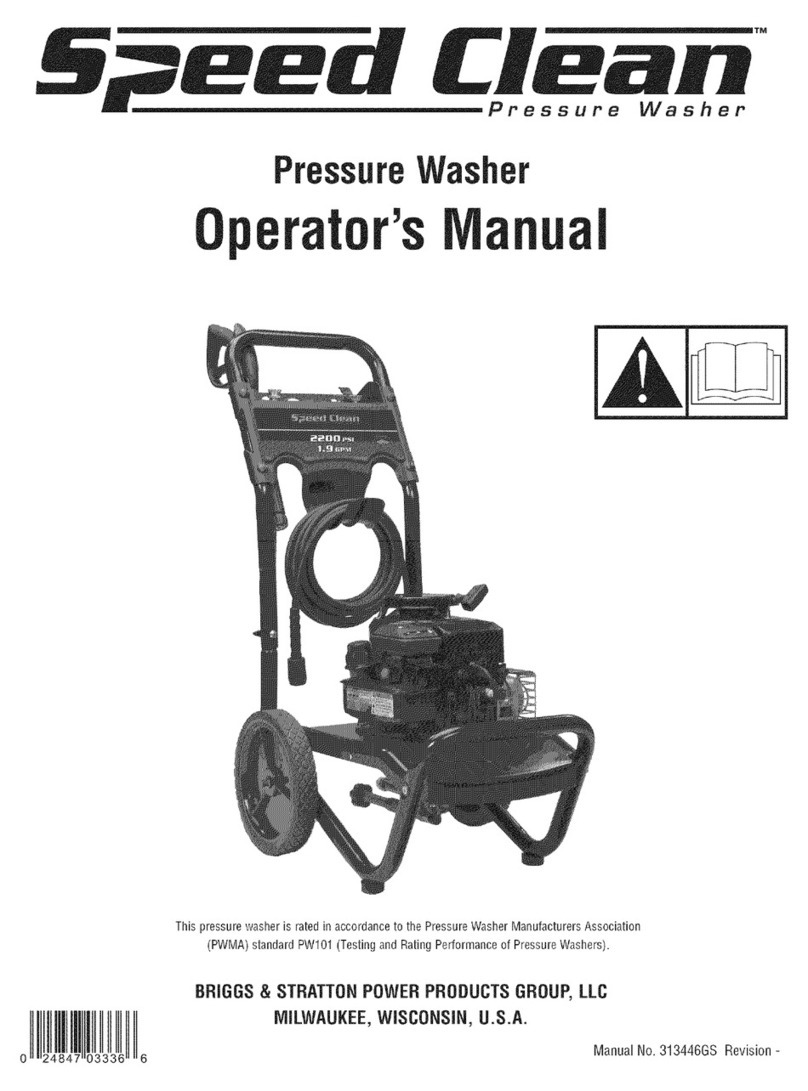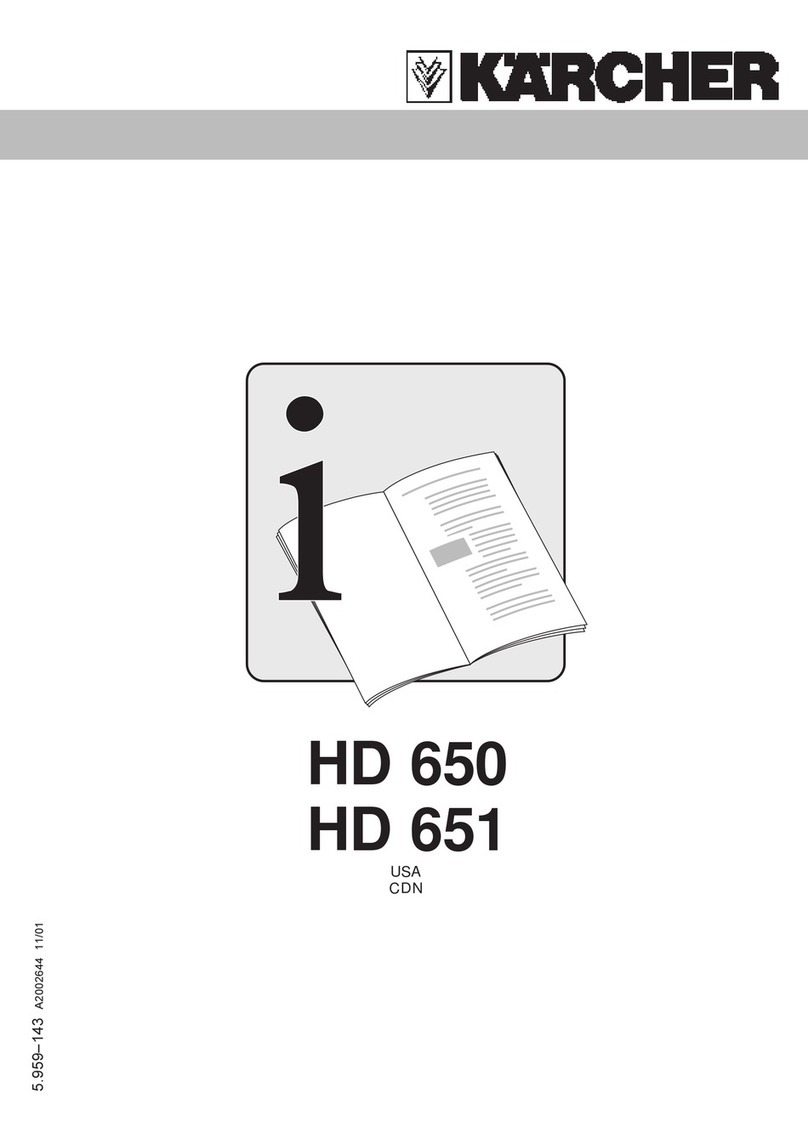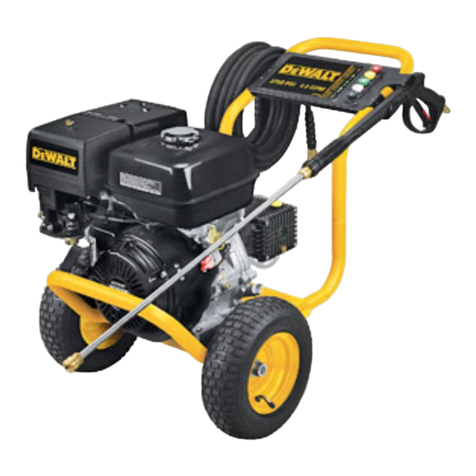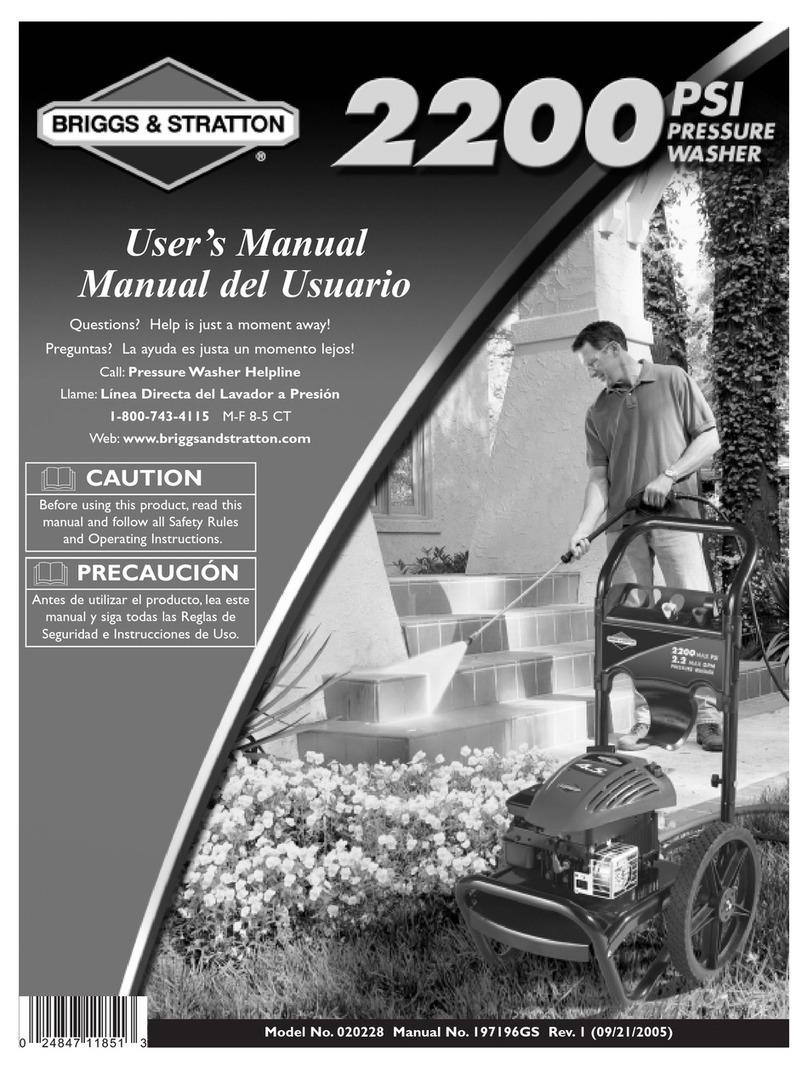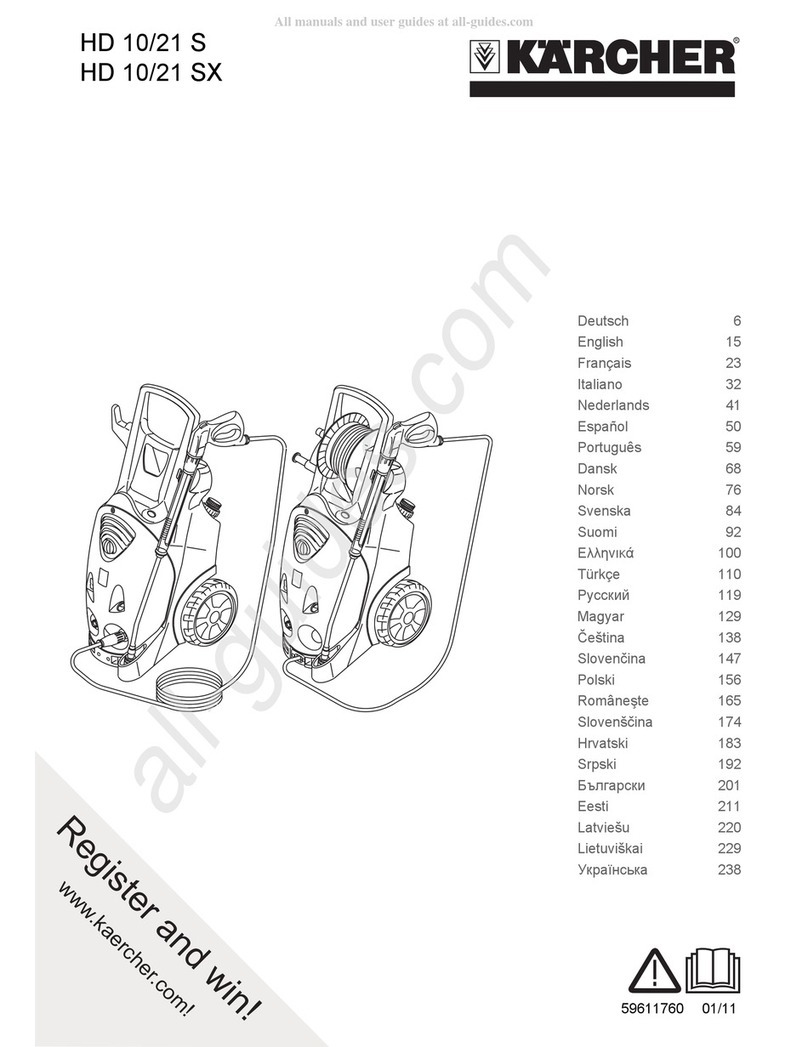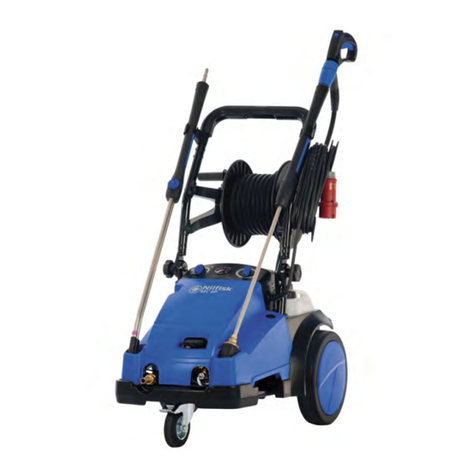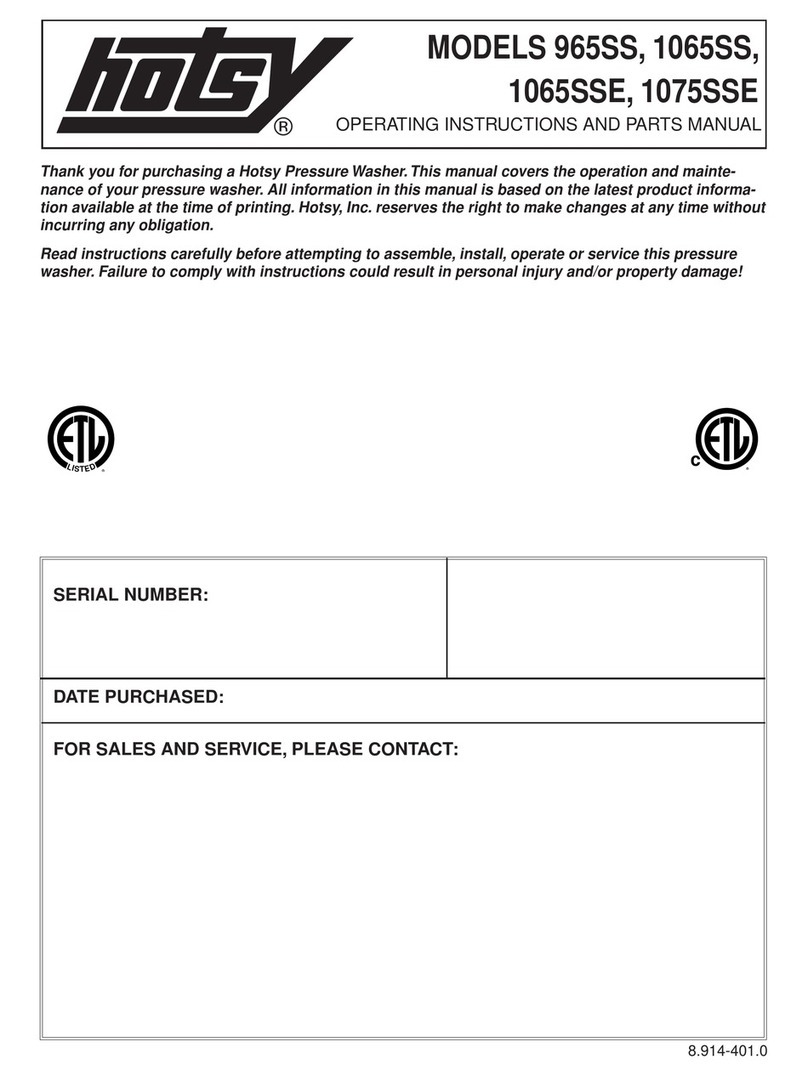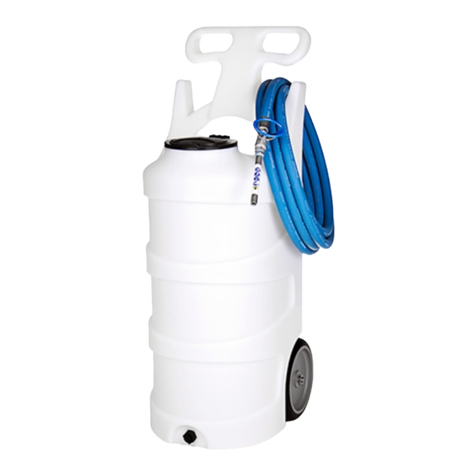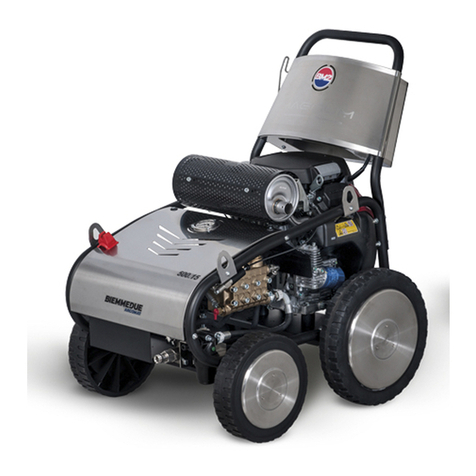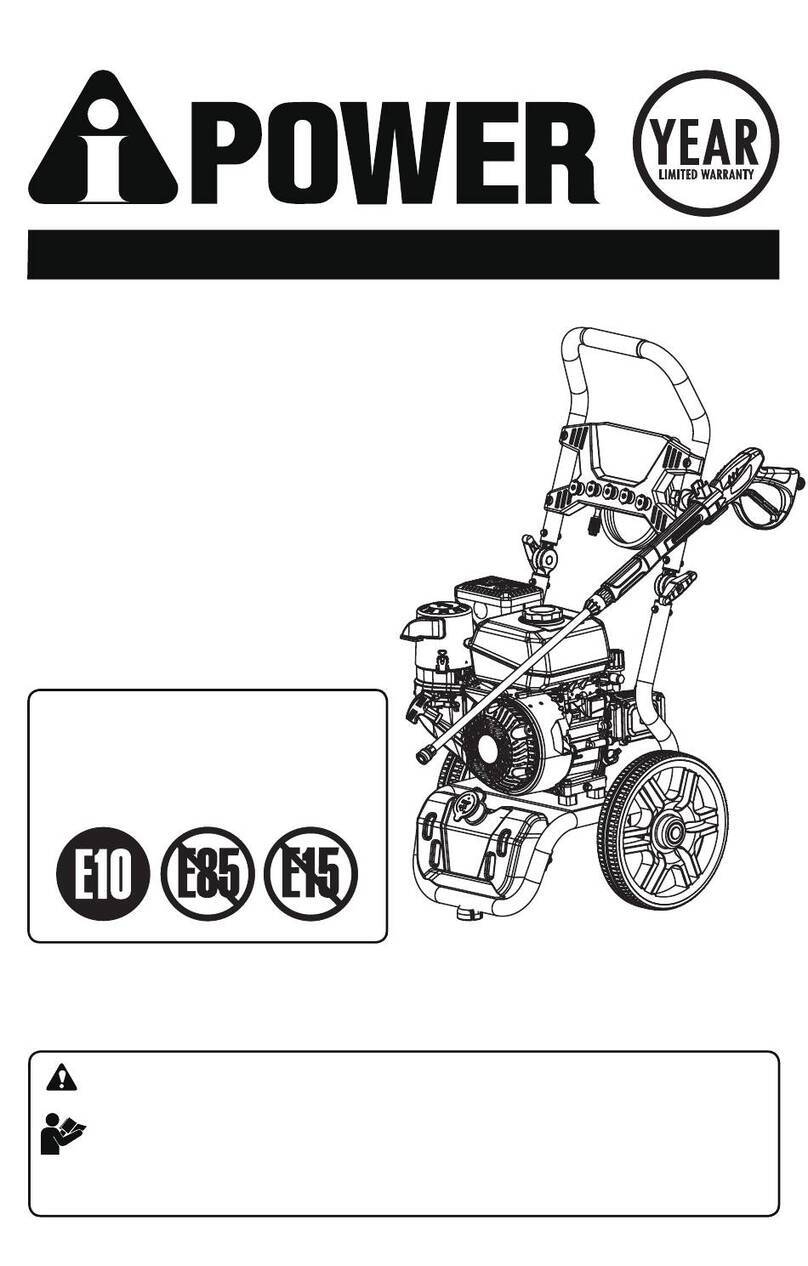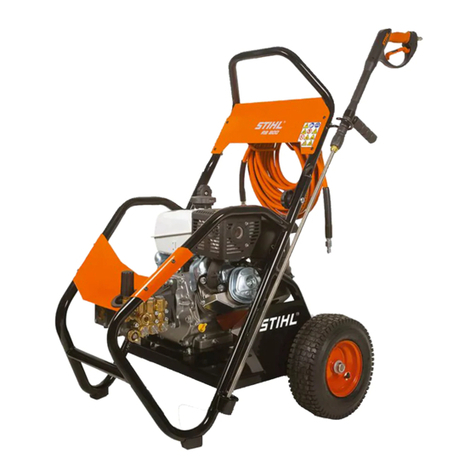Speed Clean 1909-0 User manual

Owner’s Manual / Manual del Propietario
Questions? Help is just a moment away!
Preguntas? La ayuda es justa un momento lejos!
Call: Pressure Washer Helpline
Llame: Línea Directa del Lavador a Presión - 1-800-743-4115 M-F 8-5 CT
Model No. 1909-0 (2300 PSI Pressure Washer) Manual No. 192324GS Revision 0 (12/18/2002)
2300PSI
BRIGGS & STRATTON POWER PRODUCTS GROUP, LLC
JEFFERSON,WISCONSIN, U.S.A.
SpeedClean™ is a trademark of Briggs & Stratton Power Products.
SpeedClean™ es una marca registrada de Briggs & Stratton Power Products.

Speed Clean™ 2300 PSI Pressure Washer
2
TABLE OF CONTENTS
Safety Rules. . . . . . . . . . . . . . . . . . . . . . . . . . . . . . . . . . 2-3
Know Your Pressure Washer . . . . . . . . . . . . . . . . . . . . . . 4
Assembly. . . . . . . . . . . . . . . . . . . . . . . . . . . . . . . . . . . . 5-7
Operation . . . . . . . . . . . . . . . . . . . . . . . . . . . . . . . . . . 8-10
Product Specifications. . . . . . . . . . . . . . . . . . . . . . . . . . . 11
Maintenance . . . . . . . . . . . . . . . . . . . . . . . . . . . . . . . 11-13
Storage. . . . . . . . . . . . . . . . . . . . . . . . . . . . . . . . . . . . . . 14
Troubleshooting . . . . . . . . . . . . . . . . . . . . . . . . . . . . . . . 15
Replacement Parts. . . . . . . . . . . . . . . . . . . . . . . . . . . 16-17
Warranty . . . . . . . . . . . . . . . . . . . . . . . . . . . . . . . Last Page
EQUIPMENT
DESCRIPTION
Read this manual carefully and become
familiar with your pressure washer. Know its
applications, its limitations and any hazards
involved.
Every effort has been made to ensure that information in this
manual is accurate and current. However, Briggs & Stratton
reserves the right to change, alter or otherwise improve the
product and this document at any time without prior notice.
SAFETY RULES
This is the safety alert symbol. It is used to
alert you to potential personal injury hazards.
Obey all safety messages that follow this
symbol to avoid possible injury or death.
The safety alert symbol ( ) is used with a signal word
(DANGER, CAUTION,WARNING), a pictorial and/or a
safety message to alert you to hazards. DANGER indicates
a hazard which, if not avoided, will result in death or serious
injury. WARNING indicates a hazard which, if not avoided,
could result in death or serious injury. CAUTION
indicates a hazard which, if not avoided, might result in
minor or moderate injury. CAUTION, when used
without the alert symbol, indicates a situation that could
result in equipment damage. Follow safety messages to
avoid or reduce the risk of injury or death.
In the State of California a spark arrester is required by law
(Section 4442 of the California Public Resources Code).
Other states may have similar laws. Federal laws apply on
federal lands. If you equip the muffler with a spark arrester,
it must be maintained in effective working order.
The engine exhaust from this product contains
chemicals known to the State of California to cause
cancer, birth defects, or other reproductive harm.
WARNING
• Keep water spray away from electric wiring or fatal electric
shock may result.
Spray contact with electrical wiring can result in
electrocution.
WARNING
• Operate pressure washer ONLY outdoors.
• Use a respirator or mask whenever there is a chance that
vapors may be inhaled.
• Read all instructions with mask so you are certain the mask will
provide the necessary protection against inhaling harmful vapors.
Running engine gives off carbon monoxide, an
odorless, colorless, poison gas.
Some chemicals or detergents may be harmful if
inhaled or ingested, causing severe nausea,
fainting or poisoning.
Breathing carbon monoxide will cause nausea,
fainting or death.
DANGER
• Keep spray nozzle between 8 to 24 inches away from cleaning
surface.
• Operate this unit on a stable surface.
• The cleaning area should have adequate slopes and drainage to
reduce the possibility of a fall due to slippery surfaces.
• Be extremely careful if you must use the pressure washer from
a ladder, scaffolding or any other relatively unstable location.
• Firmly grasp spray gun with both hands when using high
pressure spray to avoid injury if gun kicks back.
Use of pressure washer can create puddles and
slippery surfaces.
High pressure spray could cause you to fall if
you are too close to the cleaning surface.
WARNING

Speed Clean™ 2300 PSI Pressure Washer
3
• DO NOT touch hot surfaces.
• Allow equipment to cool before touching.
Running engines produce heat.Temperature of
muffler and nearby areas can reach or exceed
150°F (65°C).
Severe burns can occur on contact.
WARNING
WHEN ADDING FUEL
• Turn pressure washer OFF and let it cool at least 2 minutes
before removing gas cap.
• Fill fuel tank outdoors.
• DO NOT overfill tank.Allow space for fuel expansion.
• Keep fuel away from sparks, open flames, pilot lights, heat, and
other ignition sources.
• DO NOT light a cigarette or smoke.
WHEN OPERATING EQUIPMENT
• DO NOT tip engine or equipment at angle which causes fuel
to spill.
• DO NOT spray flammable liquids.
WHEN TRANSPORTING OR REPAIRING EQUIPMENT
• Transport/repair with fuel tank EMPTY or with fuel shutoff
valve OFF.
WHEN STORING FUEL OR EQUIPMENT WITH FUEL
IN TANK
• Store away from furnaces, stoves, water heaters, clothes
dryers or other appliances that have pilot light or other
ignition source because they can ignite fuel vapors.
Fuel and its vapors are extremely flammable and
explosive.
Fire or explosion can cause severe burns or
death.
WARNING
• NEVER aim the spray gun at people, animals or plants.
• DO NOT allow CHILDREN to operate the pressure washer.
• NEVER repair high pressure hose. Replace it.
The high pressure stream of water that this
equipment produces can pierce skin and its
underlying tissues, leading to serious injury and
possible amputation.
WARNING
• DO NOT tamper with governed speed.
• DO NOT operate the pressure washer above the rated
pressure.
Excessively high or low operating speeds increase risk
of injury and damage to pressure washer.
CAUTION
• DO NOT wear loose clothing, jewelry or anything that may
be caught in the starter or other rotating parts.
• Tie up long hair and remove jewelry.
Starter and other rotating parts can entangle
hands, hair, clothing, or accessories.
WARNING
WHEN ADJUSTING OR MAKING REPAIRS TOYOUR
PRESSURE WASHER
• Disconnect the spark plug wire from the spark plug and place
the wire where it cannot contact spark plug.
Unintentional sparking can result in fire or
electric shock.
WARNING
• Always wear eye protection when you use this equipment or
when you are in the vicinity where the equipment is in use.
High pressure spray can cause paint chips or
other particles to become airborne.
WARNING
• DO NOT point spray gun at glass when in the jet spray mode.
• NEVER aim the spray gun at plants.
High pressure spray may damage fragile items including
glass.
CAUTION

Fuel Cap
Speed Clean™ 2300 PSI Pressure Washer
4
KNOWYOUR PRESSURE WASHER
Read this owner’s manual and safety rules before operating your pressure washer.
Compare the illustrations with your pressure washer to familiarize yourself with the locations of various controls and
adjustments. Save this manual for future reference.
High Pressure Hose
Adjustable Nozzle
Throttle Control Lever
High Pressure Outlet
& Water Inlet
Pump equipped with Automatic
Cool Down System
Spray Gun
Oil Fill/Dipstick
Recoil Starter
Choke Lever
Air Filter
Chemical Injection
Siphon/Filter
Adjustable Nozzle — Always attached to nozzle
extension.Adjustable nozzle allows you to adjust spray
pressure and spray pattern.
Air Filter — Dry type filter element limits the amount of
dirt and dust that gets in the engine.
Automatic Cool Down System — Cycles water
through pump when water reaches 125°-155°F.Warm
water will discharge from pump onto ground.This system
prevents internal pump damage.
Chemical Injection Siphon/Filter — Use to siphon
detergent or other pressure washer chemicals into the low
pressure stream.
Choke Lever — Prepares a cold engine for starting.
DataTag (not shown, near rear of base plate) —
Provides model, revision and serial number of pressure washer.
Please have these readily available if calling for assistance.
Fuel Cap — Fill tank with regular unleaded fuel here.
Always leave room for fuel expansion.
High Pressure Hose — Connect one end to water
pump and the other end to spray gun.
High Pressure Outlet — Connection for high pressure
hose.
Oil Fill/Dipstick — Check and fill with oil here.
Pump — Develops high pressure.
Recoil Starter — Used for starting the engine manually.
Spray Gun — Controls the application of water onto
cleaning surface with trigger device. Includes safety latch.
Throttle Control Lever — Sets engine in starting mode
for recoil starter and stops a running engine.
Water Inlet — Connection for garden hose.

Speed Clean™ 2300 PSI Pressure Washer
5
IMPORTANT: Read entire owner’s manual before you
attempt to assemble or operate your new pressure washer.
REMOVE PRESSURE
WASHER FROM
CARTON
1. Remove the parts bag, accessories, and inserts included
with pressure washer.
2. Slice two corners at the end of carton from top to
bottom so the panel can be folded down flat.
3. Remove pressure washer from carton.
Carton Contents
Items in the carton include:
• Main Unit
• Handle
• High Pressure Hose
• Spray Gun
• Nozzle Extension
• Safety Goggles
• Oil Bottle
• Parts Bag (which includes the following):
• Owner’s Manual
• Engine Manual
• Owner’s Registration Card
• Handle Attachment Hardware
PREPARING PRESSURE
WASHER FOR USE
If you have any problems with the assembly of your
pressure washer or if parts are missing or damaged, call the
pressure washer helpline at 1-800-743-4115. If calling for
assistance, please have the model, revision, and serial
number from the data tag available.
To prepare your pressure washer for operation, you
will need to perform these tasks:
1. Fill out and send in registration card.
2. Attach handle to main unit.
3. Add oil to the engine crankcase.
4. Add fuel to the fuel tank.
5. Connect the high pressure hose to the spray gun and
the pump.
6. Connect the water supply to the pump.
7. Attach nozzle extension to spray gun.
Attach Handle
1. Place the handle assembly onto the handle supports
connected to the main unit. Make sure the holes in the
handle align with the holes on the handle supports
(Figure 1).
NOTE: It may be necessary to move the handle supports
from side to side in order to align the handle so it will slide
over the handle supports.
2. Insert the carriage bolts through the holes from the
outside of the unit and attach a plastic knob from the
inside of the unit (Figure 2).Tighten by hand.
3. Insert one of the “L” hooks through the hole just
under the billboard on the left side of the handle
(viewing from rear of unit). Hold the hook in place
with a pliers and attach the locknut with a
7/16” wrench (Figure 3).
4. Insert the other “L” hook through the hole just above
the billboard on the right side of the handle (viewing
from rear of unit). Hold the hook in place with a pliers
and attach the locknut with a 7/16” wrench (Figure 3).
Align Holes
Handle
Handle
Supports
Figure 1 — Attach Handle to Base
Figure 2 — Secure Handle
Hose Hook
Spray Gun
Hook
Figure 3 — Attach “L” Hooks to Handle

Speed Clean™ 2300 PSI Pressure Washer
6
Add Engine Oil
IMPORTANT: Any attempt to crank or start the engine
before it has been properly serviced with the
recommended oil may result in an engine failure.
• Place pressure washer on a level surface.
• Refer to engine owners manual to add recommended oil
to engine.
NOTE: Check Oil Often During Engine Break–in.
Add Fuel
WARNING! NEVER fill fuel tank indoors. NEVER
fill fuel tank when engine is running or hot.Allow unit
to cool for two minutes before refueling. DO NOT
light a cigarette or smoke when filling the fuel tank.
WARNING! DO NOT overfill the fuel tank.
Always allow room for fuel expansion.
• Place pressure washer on a level surface.
• Refer to engine owners manual to add recommended
fuel to engine.
Connect Hose and Water Supply to
Pump
IMPORTANT: To avoid pump damage, you must assemble
the nozzle extension to the spray gun and attach all hoses
before you start the engine.
1. Uncoil the high pressure hose and attach one end of
the hose to the base of the spray gun (Figure 5).
Tighten by hand.
2. Attach the other end of the high pressure hose to the
high pressure outlet on the pump (Figure 6).Tighten by
hand.
3. Before you connect your garden hose to the water
inlet, inspect the inlet screen (Figure 7). Clean the
screen if it contains debris or have it replaced if
damaged. Refer to the section “O-Ring Maintenance”
on page 13 if the inlet screen is damaged. DO NOT
RUN THE PRESSURE WASHER IF THE INLET
SCREEN IS DAMAGED.
Connect high
pressure hose
here
Figure 5 — Connect High Pressure Hose to Spray Gun
Figure 6 — Connect High Pressure Hose to Pump

Speed Clean™ 2300 PSI Pressure Washer
7
4. Run water through your garden hose for 30 seconds
to clean out any debris.
IMPORTANT: DO NOT siphon standing water for the
water supply. Use ONLY cold water (less than 100°F).
5. Connect the garden hose (not to exceed 50 feet in
length) to the water inlet.Tighten by hand (Figure 7).
CAUTION! There MUST be at least ten feet of
unrestricted garden hose between the pressure washer
inlet and any flow shut off device, such as a ‘Y’ shut-off
connector or other convenience-type water shut-off valve.
Damage to pressure washer resulting from disregarding
this warning will not be covered by the warranty.
6. Turn ON the water and squeeze the trigger on the
gun to purge the pump system of air and impurities.
CAUTION! Before starting the pressure washer,
be sure you are wearing adequate eye protection.
CHECKLIST BEFORE
STARTING ENGINE
Review the unit’s assembly to ensure you have performed
all of the following.
1. Make sure the handle is in place and secure.
2. Check that oil has been added to the proper level in
the engine crankcase.
3. Add the proper gasoline to fuel tank.
4. Check for properly tightened hose connections.
5. Check to make sure that there are no kinks, cuts, or
damage to the high pressure hose.
6. Provide a proper water supply at an adequate flow.
7. Be sure to read “Safety Rules” and “How To UseYour
Pressure Washer” before using the pressure washer.
Inspect inlet
screen, DO NOT
use if damaged;
clean if dirty.
Figure 7 — Connect the Garden Hose to Water Inlet

Speed Clean™ 2300 PSI Pressure Washer
8
HOW TO USE YOUR
PRESSURE WASHER
If you have any problems operating your pressure washer,
please call the pressure washer helpline at 1-800-743-4115.
How to StartYour Pressure Washer
To start your pressure washer for the first time, follow
these instructions step-by-step.This starting information
also applies if you have let the pressure washer sit idle for
at least a day.
1. Place the pressure washer near an outside water
source capable of supplying water at a flow rate
greater than 3.0 gallons per minute and no less than
20 PSI at the pressure washer end of the garden hose.
2. Check that the high pressure hose is tightly connected
to the spray gun and to the pump. See “Preparing
Pressure Washer for Use” for illustrations.
3. Make sure unit is in a level position.
4. Connect the garden hose to the water inlet on the
pressure washer pump. Turn ON the water.
CAUTION! DO NOT run the pump without the water
supply connected and turned on.You must follow this
caution or the pump will be damaged.
5. Attach the adjustable nozzle extension to the spray
gun (Figure 8).Tighten by hand.
6. Position the nozzle in the low pressure mode (see
“How to Use the Adjustable Nozzle”) and squeeze the
trigger on the spray gun to relieve the air pressure
caused by turning ON the water.Water will flow out
of the spray gun in a thin stream. Continue to hold
trigger until there is a steady stream of water and no
air remains in the system.This will make it easier to
pull start the engine. Release the trigger.
7. Engage the safety latch to the spray gun trigger (Figure 9).
8. Start the engine according to instructions given in the
engine owner’s manual.
NOTE: Always keep the throttle lever in the “Fast”
position when operating the pressure washer.
NOTE: If the recoil starter is hard to pull, squeeze the
spray gun trigger to relieve internal pump pressure.
How to StopYour Pressure Washer
1. Let the engine idle for two minutes.
2. Turn engine off according to instructions given in the
engine owner’s manual.
3. Squeeze trigger on the spray gun to relieve
pressure in the hose.
NOTE: A small amount of water will squirt out when you
release the pressure.
Figure 8 — Connect Nozzle Extension to Spray Gun
Safety Latch
Figure 9 — Spray Gun with Safety Latch Engaged

Speed Clean™ 2300 PSI Pressure Washer
9
How to Use the Adjustable Nozzle
You should now know how to START and STOP your
pressure washer.The information in this section will tell
you how to adjust the spray pattern and to apply detergent
or other cleaning chemicals.
WARNING! NEVER adjust spray pattern when
spraying. NEVER put hands in front of nozzle to
adjust spray pattern.
1. Slide the nozzle forward when you wish to adjust the
spray to low pressure mode (Figure 10). Slide the
nozzle backward to achieve high pressure.
2. Point the nozzle down towards a firm surface and
press the trigger to test the pattern (Figure 11).
3. Twisting the nozzle adjusts the spray pattern from a
narrow pattern to a fan pattern (Figure 12).
4. For most effective cleaning, keep spray nozzle from
8 to 24 inches away from cleaning surface.
5. If you get the spray nozzle too close, especially using
high pressure mode, you may damage the surface being
cleaned.
6. DO NOT get closer than 6 inches when cleaning tires.
Applying Detergent with the
Adjustable Nozzle
IMPORTANT: Use soaps designed specifically for
pressure washers. Household detergents could damage
the pump.
CAUTION!You must attach all hoses before you start
the engine. Starting the engine without all the hoses
connected and without the water turned ON will damage
the pump.
To apply detergent, follow these steps:
1. Review the use of adjustable nozzles.
2. Prepare the detergent solution as required by the job.
3. Place the filter end of the chemical injection hose into
the detergent container.
CAUTION! Keep the chemical injection hose from
coming in contact with the hot muffler.
Slide nozzle backward
for High Pressure
Mode
Slide nozzle forward for low
pressure mode and
detergent application
Figure 10 — Adjusting Nozzle for Pressure
Figure 11 — Testing the Spray Pattern
Figure 12 — Adjusting the Nozzle for Spray Pattern
Rotate nozzle
counterclockwise for fan
spray pattern
Rotate nozzle clockwise
for narrow spray pattern

Speed Clean™ 2300 PSI Pressure Washer
10
4. Slide the adjustable nozzle forward to low pressure
mode. Detergent cannot be applied with the nozzle in
high pressure position.
5. Make sure the garden hose is connected to the water
inlet. Check that the high pressure hose is connected
to the spray gun and the pump. Start the engine.
6. Apply the detergent to a dry surface, starting at lower
portion of area to be washed and work upward, using
long, even, overlapping strokes.
7. Allow the detergent to "soak in" for 3-5 minutes
before washing and rinsing. Reapply as needed to
prevent surface from drying. DO NOT allow the
detergent to dry on (prevents streaking).
IMPORTANT: You must flush the chemical injection
system after each use by placing the filter into a bucket of
clean water, then run the pressure washer in low pressure
for 1-2 minutes.
Pressure Washer Rinsing
WARNING! Be extremely careful if you must use
the pressure washer from a ladder, scaffolding or any
other relatively unstable location.When you press the
trigger, the recoil from the initial spray could cause
you to fall.The high pressure spray could also cause
you to fall if you are too close to the cleaning surface.
For Rinsing:
1. Slide the nozzle backward to high pressure, press the
trigger and wait for the detergent to clear.
CAUTION! Firmly grasp spray gun with both
hands when using high pressure spray to avoid
injury if gun kicks back.
NOTE: You can also stop detergent from flowing by simply
removing chemical injection hose from bottle.
2. Keep the spray gun a safe distance from the area you
plan to spray.
3. Apply a high pressure spray to a small area, then check
the surface for damage. If no damage is found, it is okay
to continue cleaning.
4. Start at the top of the area to be rinsed, working
down with same overlapping strokes as you used for
washing and applying detergent.
Automatic Cool Down System
(Thermal Relief)
If you run the engine on your pressure washer for
3-5 minutes without pressing the trigger on the spray gun,
circulating water in the pump can reach a temperature
between 125°–155°F.When the water reaches this
temperature, the automatic cool down system engages and
cools the pump by discharging the warm water onto
the ground. This system prevents internal damage to the
pump.

Speed Clean™ 2300 PSI Pressure Washer
11
SPECIFICATIONS
Outlet Pressure . . . . . 2300 psi
Flow Rate . . . . . . . . . . 2.0 gallons per minute (gpm)
Detergent . . . . . . . . . . Use detergent approved for
pressure washers
Water Supply . . . . . . Not to Exceed 100°F
Temperature
Automatic Cool . . . . Will cycle when water
Down System reaches 125°-155°F
Shipping Weight . . . .64 lbs.
GENERAL MAINTENANCE
RECOMMENDATIONS
The pressure washer warranty does not cover items that
have been subjected to operator abuse or negligence.To
receive full value from the warranty, the operator must
maintain the pressure washer as instructed in this manual.
• Some adjustments will need to be made periodically to
properly maintain your pressure washer.
• All maintenance in this manual and the engine owner’s
manual should be made at least once each season.
• Once a year you should clean or replace the spark plug,
clean or replace the air filter and check the spray gun
and adjustable nozzle extension assembly for wear.A
new spark plug and clean air filter assure proper fuel-air
mixture and help your engine run better and last longer.
Please refer to your engine owner’s manual for more
details.
• If equipped with inflatable tires, keep the air pressure at
the value marked on the tire or within 15 and 40 psi.
Before Each Use
1. Check engine oil level.
2. Check water inlet screen for damage.
3. Check in-line filter for damage.
4. Check high pressure hose for leaks.
5. Check chemical injection hose and filter for damage.
6. Check spray gun and adjustable nozzle extension
assembly for leaks.
7. Rinse out garden hose to flush out debris.
PRESSURE WASHER
MAINTENANCE
Check and Clean Inlet Screen
Examine the screen on the water inlet. Clean it if the
screen is clogged or replace it if screen is damaged.
Check High Pressure Hose
The high pressure hose can develop leaks from wear,
kinking, or abuse. Inspect the hose each time before using
it. Check for cuts, leaks, abrasions or bulging of cover,
damage or movement of couplings. If any of these
conditions exist, replace the hose immediately.
WARNING! NEVER repair a high pressure hose.
Replace it with another hose that exceeds the
maximum pressure rating of your pressure washer.
Check Chemical Injection Hose
Examine the filter on the detergent tube and clean if
clogged.The tube should fit tightly on the barbed fitting.
Examine the tube for leaks or tears. Replace the filter or
tube if either is damaged.
Check Gun and Adjustable Nozzle
Extension
Examine the hose connection to the spray gun and make
sure it is secure.Test the trigger by pressing it and making
sure it “springs back” into place when you release it. Put
the safety latch in the ON position and test the trigger.You
should not be able to press the trigger.
Purge Pump of Air and
Contaminants
To remove air from the pump, follow these steps:
1. Set up the pressure washer as described in “Preparing
Pressure Washer For Use”. Connect the water supply
and turn water on.
2. Pull the trigger on the spray gun and hold.
3. When the water supply is steady and constant, engage
the safety latch.

Speed Clean™ 2300 PSI Pressure Washer
12
To remove contaminants from the pump, follow
these steps:
1. Set up the pressure washer as described in “Preparing
Pressure Washer For Use”. Connect the water supply
and turn water on.
2. Remove the nozzle extension from the spray gun.
3. Start the engine according to instructions in “How To
Use Your Pressure Washer”.
4. Squeeze the trigger on the spray gun and hold.
5. When the water supply is steady and constant, engage
the safety latch and refasten the nozzle extension.
Check In-Line Filter
Refer to Figure 13 and service the in-line filter if it
becomes clogged, as follows:
2. If the screen is damaged, the o-ring kit contains a
replacement in-line filter screen and an o-ring. If
undamaged, reuse screen.
3. Place the in-line filter screen into the threaded end of
the nozzle extension. Direction does not matter. Push
the screen in with the eraser end of a pencil until it
rests flat at the bottom of the opening.Take care to
not bend the screen.
4. Place the o-ring into the recess. Push the o-ring snugly
against the in-line filter screen.
5. Assemble the nozzle extension to the spray gun, as
described earlier in this manual.
Nozzle Maintenance
A pulsing sensation felt while squeezing the spray gun
trigger may be caused by excessive pump pressure.The
principal cause of excessive pump pressure is a nozzle
clogged or restricted with foreign materials, such as dirt,
etc.To correct the problem, immediately clean the nozzle
using the tools included with your pressure washer and
follow these instructions:
1. Shut off the engine and turn off the water supply.
2. Detach the nozzle extension from the spray gun.Twist
the nozzle clockwise to the stream position. Using the
supplied 2mm (5/64) allen wrench, remove the orifice
from the end of the nozzle extension (Figure 15).
3. Remove the in-line filter from the other end of the
nozzle extension.
4. Use the wire included in the kit (or a small paper clip)
to free any foreign material clogging or restricting the
orifice (Figure 15).
5. Using a garden hose, remove additional debris by back
flushing water through the nozzle extension
(Figure 16). Back flush between 30 to 60 seconds.Turn
the adjustable nozzle extension to stream spray and
move the nozzle from low to high while flushing.
6. Reinstall the orifice and in-line filter into the nozzle
extension. DO NOT overtighten the orifice with the
allen wrench.
7. Reconnect the nozzle extension to the spray gun.
8. Reconnect the water supply, turn on the water, and
start the engine.
9. Test the pressure washer by operating with nozzle in
the high and in the low positions.
Nozzle Extension
Filter Screen
O-ring
Figure 13 — Clean In-Line Filter
Orifice
Figure 15 — Removing and Cleaning Orifice
Figure 16 — Backflushing the Nozzle

Speed Clean™ 2300 PSI Pressure Washer
13
O–Ring Maintenance
Through the normal operation of your pressure washer,
o–rings, which keep the connections of the hoses and spray
gun tight and leak–free, may become worn or damaged.
An O–Ring Maintenance Kit is provided with your pressure
washer which includes replacement o-rings, rubber washer
and water inlet filter. Refer to the instruction sheet
provided in the kit to service your unit’s o-rings. Note that
not all of the parts in the kit will be used on your unit.
To remove a worn or damaged o–ring:
• Use a small flathead screwdriver to get underneath the
o-ring and pry it off.
Cleaning Chemical Injection Hose
If you used the chemical injection hose, you must flush it
with clean water before stopping the engine.
1. Place the chemical injection hose in a bucket full of
clean water.
2. Slide the adjustable nozzle forward to the low pressure
position. Flush for 1-2 minutes.
3. Shut off the engine.
IMPORTANT: Simply shutting OFF engine will not
release pressure in the system. When the engine has
shut down, squeeze the trigger on the spray gun to
relieve the pressure in the hose.
Pump Maintenance
Changing Pump Oil
Change oil every 50 hours or once yearly, whichever
occurs first.
NOTE: Purchase a premeasured bottle of pump oil, item
number 190586GS, by contacting the nearest authorized
service center.
Change pump oil as follows:
• Drain engine oil and fuel from pressure washer.
• Use a 8mm allen wrench to remove the black pump oil
cap between the high pressure outlet and garden hose
inlet (Figure 14).
• Tilt the pressure washer to drain the oil into an
approved container until it drips slowly from the pump.
• Tilt the pressure washer in the opposite direction and
empty the premeasured pump oil bottle into the same
opening (a small funnel may be helpful).
• Install the black pump oil cap and tighten firmly.
• Set the pressure washer in the upright position.Add fuel
and engine oil.
ENGINE MAINTENANCE
See the engine owner’s manual for instructions on how to
properly maintain the engine.
CAUTION! Avoid prolonged or repeated skin
contact with used motor oil. Used motor oil has
been shown to cause skin cancer in certain
laboratory animals.Thoroughly wash exposed areas
with soap and water.
KEEP OUT OF REACH OF CHILDREN. DON'T
POLLUTE. CONSERVE RESOURCES. RETURN
USED OIL TO COLLECTION CENTERS.
Oil Cap
Figure 14 - Changing Pump Oil

Speed Clean™ 2300 PSI Pressure Washer
14
PREPARING THE UNIT
FOR STORAGE
Water should not remain in the unit for long periods of
time. Sediments or minerals can deposit on pump parts and
“freeze” pump action. If you do not plan to use the
pressure washer for more than 30 days, follow this
procedure:
1. Flush chemical injection hose by placing the filter into a
pail of clean water while running pressure washer in
low pressure mode (adjustable nozzle in the forward
position). Flush for one to two minutes.
2. Shut off the engine and let it cool, then remove high
pressure and garden hoses. Disconnect spark plug wire
from spark plug.
3. Empty the pump of all pumped liquids by pulling the
recoil handle about 6 times.This should remove most
of the liquid in the pump.
4. Use PumpSaver to prevent corrosion build up and
freezing of pump.
5. Store unit in a clean, dry area.
Protecting the Pump
To protect the pump from damage caused by mineral
deposits or freezing, use PumpSaver to treat pump.This
prevents freeze damage and lubricates pistons and seals.
NOTE: PumpSaver is available as an optional accessory. It
is not included with the pressure washer. Contact the
nearest authorized service center to purchase PumpSaver.
CAUTION!You must protect your unit from freezing
temperatures. Failure to do so will permanently damage
your pump and render your unit inoperable. Freeze damage
is not covered under warranty.
CAUTION! Read and follow all cautions and
warnings on the PumpSaver can label.Always wear
eye protection when using PumpSaver.
To use PumpSaver, make sure the pressure washer is
turned off and disconnected from supply water. Read and
follow all instructions and warnings given on the PumpSaver
container.
NOTE: PumpSaver will drip from pump after treatment
and will stain wood and concrete.
NOTE: If PumpSaver is not available, draw RV antifreeze
(non-alcohol) into the pump by pouring the solution into a
3-foot section of garden hose connected to inlet adapter
and pulling recoil handle twice.
STORING THE ENGINE
See the engine owner’s manual for instructions on how to
properly prepare the engine for storage.

Speed Clean™ 2300 PSI Pressure Washer
15
TROUBLESHOOTING
Problem
Cause
Correction
Pump has following
problems: failure to
produce pressure, erratic
pressure, chattering, loss
of pressure, low water
volume.
1. Nozzle in low pressure mode.
2. Water inlet is blocked.
3. Inadequate water supply.
4. Inlet hose is kinked or leaking.
5. Clogged inlet hose strainer.
6. Water supply is over 100°F.
7. High pressure hose is blocked or
leaks.
8. Gun leaks.
9. Nozzle is obstructed.
10. Pump is faulty.
1. Pull nozzle backward for high pressure
mode.
2. Clear inlet.
3. Provide adequate water flow.
4. Straighten inlet hose, patch leak.
5. Check and clean inlet hose strainer.
6. Provide cooler water supply.
7. Clear blocks in outlet hose.
8. Replace gun.
9. Clean nozzle.
10. Contact Briggs and Stratton service
facility.
Detergent fails to mix
with spray.
1. Detergent siphoning tube is not
submerged.
2. Chemical filter is clogged or cracked.
3. Dirty in-line filter.
4. Nozzle is in high pressure mode.
1. Insert detergent siphoning tube into
detergent.
2. Clean or replace filter/detergent
siphoning tube.
3. See “Check In-Line Filter” on page 12.
4. Push nozzle forward for low pressure
mode.
Engine runs good at no-
load but “bogs” when
load is added.
Engine speed is too slow.
Move throttle control to FAST position. If
engine still “bogs down”, contact Briggs and
Stratton service facility.
Pressure washer stops
during operation.
Out of gasoline.
Fill fuel tank.

Speed Clean™ 2300 PSI Pressure Washer
16
EXPLODED VIEW AND PARTS LIST – MAIN UNIT
Item Part # Description
1 192546GS BASE
2 B191874GS HANDLE
3 191909GS BILLBOARD
4 190249GS HOSE
5 192529GS KIT, Pump Mounting Hardware
6 192128GS KIT, Hook
7 B3263GS GUN
8 B2203GS KIT, Handle Connector
9 192310GS KIT,Vibration Mount
Item Part # Description
10 21760GS ORIFICE
11 192309GS KIT, Hook
12 192050GS KIT, E-Ring
13 B3335HGS WAND,Adjustable Nozzle
14 192311GS KIT,Wheel
15 23139GS KEY
16 189970GS ASSY, Pump (see page 17)
900 NSP ENGINE
Items Not Illustrated:
Part # Description
192324GS MANUAL, Owner’s
192545GS KIT, Decals
BB3061BGS OIL, Engine

Speed Clean™ 2300 PSI Pressure Washer
17
Item Part # Description
19 190571 CAP, Oil
23 190626 CARTER
28 190627 MANIFOLD
29 190575 O-RING
30 190576 SCREW
34 190577 CONNECTION, Chemical Inlet
45 190578 PIN
46 190579 VALVE, Seat Plate, Brass
47 190580 VALVE, Seat, Stainless
62 190581 CAP
68 190582 BALL, Stainless Steel
69 190584 O-RING
76 21783 THERMO RELIEF
77 190586 OIL BOTTLE
Item Part # Description
A 190709 KIT,WOBBLE PLATE BEARING
B 190632 KIT,WATER INLET,ALUM
C 190634 KIT, OUTLET,ALUM
D 190710 KIT, PISTON
E 190591 KIT, CHECK VALVES
F 190592 KIT, INLET CHECK
G 190593 KIT, CHEMICAL INJECTION
H 190594 KIT, UNLOADER STEM
J 189971 KIT, CHEMICAL HOSE
K 190595 KIT, SEAL SET
L 190596 KIT, HEAD BRASS
NOTE: Item letters A - L are service kits and
include all parts shown within the box.
EXPLODED VIEW AND PARTS LIST – PUMP

Lavadora de Presión 2300 PSI de Speed Clean™
18
TABLA DE CONTENIDOS
Reglas De Seguridad . . . . . . . . . . . . . . . . . . . . . . . . . . . . . . 18-19
Conozca Su Generador . . . . . . . . . . . . . . . . . . . . . . . . . . . . . . 20
Ensamblaje. . . . . . . . . . . . . . . . . . . . . . . . . . . . . . . . . . . . . . 21-23
Funcionamiento . . . . . . . . . . . . . . . . . . . . . . . . . . . . . . . . . . 24-26
Especificaciones Del Producto . . . . . . . . . . . . . . . . . . . . . . . . . 27
Mantenimiento. . . . . . . . . . . . . . . . . . . . . . . . . . . . . . . . . . . 27-29
Almacenamiento. . . . . . . . . . . . . . . . . . . . . . . . . . . . . . . . . . . . 29
Diagnosticos De Averías . . . . . . . . . . . . . . . . . . . . . . . . . . . . . . 30
Piezas De Recambio . . . . . . . . . . . . . . . . . . . . . . . . . . . . . . 16-17
Garantia . . . . . . . . . . . . . . . . . . . . . . . . . . . . . . . . . . . . . . . . . . 31
DESCRIPCIÓN DEL EQUIPO
Lea este manual de manera cuidadosa y
familiarícese con su generador. Conozca sus usos,
sus limitaciones y cualquier peligro relacionado con
el mismo.
Se ha hecho cada esfuerzo posible para asegurarse que la
información que aparece en este manual es exacta y se encuentra
actualizada. Sin embargo, Briggs & Stratton se reserva el derecho a
cambiar, alterar o de otra manera mejorar, el producto y este
documento en cualquier momento, sin previo aviso.
INSTRUCCIONES DE SEGURIDAD
Éste es el símbolo de alerta de seguridad. Sirve
para advertir al usuario de un posible riesgo para
su integridad física. Siga todos los mensajes de
seguridad que figuren después de este símbolo
para evitar lesiones o incluso la muerte.
El símbolo de alerta de seguridad ( ) es usado con una palabra
(PELIGRO,ADVERTENCIA, PRECAUCIÓN), un mensaje por
escrito o una ilustración, para alertarlo acerca de cualquier
situación de peligro que pueda existir. PELIGRO indica un riesgo
el cual, si no se evita, causará la muerte o una herida grave.
ADVERTENCIA indica un riesgo el cual, si no se evita, puede
causar la muerte o una herida grave. PRECAUCIÓN indica un
riesgo, el cual, si no se evita, puede causar heridas menores o
moderadas. PRECAUCIÓN, cuando se usa sin el símbolo de
alerta, indica una situación que podría resultar en el daño del
equipo. Siga los mensajes de seguridad para evitar o reducir los
riesgos de heridas e inclusive la muerte.
El escape del motor de este producto contiene
elementos químicos reconocidos en el Estado de
California por producir cáncer, defectos de nacimiento u
otros daños de tipo reproductivo.
ADVERTENCIA
En el estado de California es obligatorio, según la ley, el uso de
apagachispas (Sección 4442 del Código de Recursos Públicos de
California). Otros estados pueden tener leyes similares. Las leyes
federales se aplican en tierras federales. Si equipa el silenciador
con un apagachispas, este deberá ser mantenido en buenas
condiciones de trabajo.
• Mantenga el chorro del agua alejado de alambrados eléctricos, de lo
contrario podrían ocurrir descargas eléctricas fatales.
El contacto del rocío con alambrado eléctrico puede
tener como resultado electrocution.
ADVERTENCIA
• Opere el lavadora de presión SOLAMENTE al aire libre.
• Utilice un respirador o máscara siempre que exista la posibilidad de
inhalar vapores.
• Lea todas las instrucciones de la máscara para asegurarse de que le
brindará la protección necesaria contra la inhalación de vapores
nocivos.
Al motor funcionar, se produce monóxido de
carbono, un gas inodoro y venenoso.
El respirar el monóxido de carbono, producirá
náusea, desmayo o la muerte.
PELIGRO
• Mantenga la boquilla de rociado de 8 a 24 pulgadas de la superficie de
limpieza.
• Opere y almacene esta unidad sobre una superficie estable.
• El área de limpieza deberá tener inclinaciones y drenajes adecuados
para disminuir la posibilidad de caídas debido a superficies resbalosas.
• Sea extremadamente cuidadoso si usa la máquina lavadora a presión
desde una escalera, andamio o cualquier superficie relativamente
inestable.
• Sujete la pistola de la hidrolavadora firmemente con ambas manos
cuando utilice el rociado a alta presión. De esta manera evitará
lesiones producidas por el posible golpe de la pistola hacia atrás.
El uso de lavadora de presión puede crear los
charcos y superficies resbalosas.
El rociado de la alta presión podría hacerlo caer si
está muy cerca de la superficie de limpieza.
ADVERTENCIA

Lavadora de Presión 2300 PSI de Speed Clean™
19
CUANDO AÑADA COMBUSTIBLE
• Apague el generador (posición OFF) y déjelo enfriar al menos por
2 minutos antes de remover la tapa de la gasolina.
• Llene el tanque al aire libre.
• NO llene demasiado el tanque. Permita al menos espacio para la
expansión del combustible.
• Mantenga la gasolina alejada de chispas, llamas abiertas, pilotos, calor y
otras fuentes de ignición.
• NO encienda un cigarrillo o fume.
CUANDO OPERE EL EQUIPO
• NO incline el motor o el equipo, de tal manera que la gasolina se
pueda derramar.
• NO rocíe líquidos inflamables.
CUANDO TRANSPORTE O REPARE EL EQUIPO
• Transporte o repare el equipo con el tanque de combustible vacío, o
con la válvula para apagar el combustible, apagada (posición OFF).
CUANDO ALMACENE O GUARDE EL EQUIPO CON
COMBUSTIBLE EN ELTANQUE
• Almacene alejado de calderas, estufas, calentadores de agua, secadoras
de ropa u otros aparatos electrodomésticos que posean pilotos u
otras fuentes de ignición, porque ellos pueden encender los vapores
de la gasolina.
La gasolina y sus vapores son extremadamente
inflamables y explosivos.
El fuego o una explosión pueden causar quemaduras
severas e inclusive la muerte.
ADVERTENCIA
• NUNCA apunte la pistola a la gente, animales o plantas.
• NO permita en ningún momento que NIÑOS operen la máquina
lavadora a presión.
• NUNCA repare la manguera de alta presión. Remplacela.
La corriente de agua de alta presión que produce
este equipo pueden perforar la piel y sus tejidos
profundos, ocasionando lesiones serias y posible
amputación.
ADVERTENCIA
• NO toque las superficies calientes.
• Permita que el equipo se enfríe antes de tocarlo.
Los motores al funcionar producen calor. La
temperatura del silenciador y de las áreas cercanas
puede alcanzar o pasar los 150°F (65°C).
Quemaduras severas pueden ocurrir al hacer contacto.
ADVERTENCIA
• NO juegue con partes que puedan aumentar o disminuir la velocidad
de mando.
• NO opere la máquina lavadora a presión con un valor de presión
superior a su clasificación de presión.
Hacer funcionar el motor a velocidades excesivas aumenta el
riesgo de lesiones personales.
PRECAUCIÓN
• NO apunte la pistola de rociado al vidrio cuando esté en el modo de
rociado a chorro.
• NUNCA apunte la pistola a plantas.
El rociado de alta presión puede dañar elementos frágiles,
incluyendo el vidrio.
PRECAUCIÓN
• NO use ropa suelta, joyas o elementos que puedan quedar atrapados
en el arranque o en otras partes rotatorias.
• Ate para arriba el pelo largo y quite la joyería.
El arrancador y otras piezas que rotan pueden
enredar las manos, el pelo, la ropa, o los accesorios.
ADVERTENCIA
• Siempre use protección para los ojos cuando utilice este equipo o
cuando esté cerca de donde se esté usando el equipo.
El rociado de alta presión puede hacer que partículas
pequeñas de pintura u otras partículas salgan
disparadas y viajen a altas velocidades.
ADVERTENCIA
CUANDO AJUSTE O HAGA REPARACIONES A SU
MÁQUINA LAVADORA DE PRESIÓN
• Siempre desconecte el alambre de la bujía y colóquelo donde no
pueda entrar en contacto con la bujía.
Chispear involuntario puede tener como resultado el
fuego o el golpe eléctrico.
ADVERTENCIA

Lavadora de Presión 2300 PSI de Speed Clean™
20
CONOZCA SU MAQUINA LAVADORA DE PRESION
Lea el manual del propietario y las reglas de seguridad antes de poner en marcha su máquina lavadora a presión.
Compare las ilustraciones con su máquina lavadora a presión para familiarizarse con las ubicaciones de los diferentes controles y ajustes.
Guarde este manual para referencias futuras.
Pistola de Rociado
Manguera de Alta Presión
Filtro y Tubo para
Recolección de Detergente
Tapa del Depósito
del Aceite
Filtro de Aire
Bomba equipado con
Automático se Enfría Sistema
Arrancador de Retroceso
Toma de Alta Presión
y Entrada de Agua
Perilla del Cebador
Palanca de la Válvula
de Regulación
Boquilla Ajustable
Arrancador de Retroceso – Usado para arrancar el motor
manualmente.
Automático se Enfría Sistema - Los ciclos regan por bomba
cuando agua alcanza 125º-155ºF. Entibiar agua descargará de la
bomba en el suelo. Este sistema previene el daño interno de
bomba.
Bomba – Desarrolla alta presión de agua.
Boquilla Ajustable – Ajusta la presión a alta o baja presión;
rociado a chorro o en abanico.
Entrada de Agua – Conexión para la manguera de jardín.
Etiqueta de Datos (no mostrado, el trasero cercano de
plato despreciable) — Proporciona el modelo, revisión y el
número de serie de lavadora de presion.Tenga por favor estos
prontamente disponible cuándo llamar para la ayuda.
Filtro de Aire – El elemento de filtro tipo seco limita la cantidad
de suciedad y polvo que se introduce en el motor.
Filtro yTubo para Recolección de Detergente – Usado para
succionar detergente de la botella de químicos a la corriente de
agua de baja presión.
Manguera de Alta Presión – Conecte un extremo a la pistola
de rociado y el otro extremo a la toma de alta presión.
Palanca de Control de laVálvula de Regulación – Coloca el
motor en modo de arranque para el arrancador de retroceso y
detiene el motor en funcionamiento.
Perilla del Cebador – Usada para arranque de motores fríos.
Pistola de Rociado – Controla la aplicación de agua sobre la
superficie de limpieza con el gatillo. Incluye cerrojo de seguridad.
Tapa del Combustible – Llene el tanque con gasolina regular
sin contenido de plomo en este punto.
Tapa del Depósito del Aceite – Llene el motor con aceite
aquí. Siempre habitación de hoja para la expansión del combustible.
Toma de Alta Presión – Conexión para la manguera de alta
presión.
Tapa del Combustible
Table of contents
Languages:
Other Speed Clean Pressure Washer manuals
